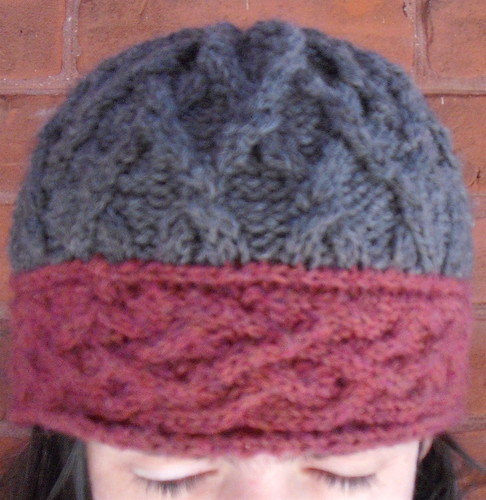Well, after six attempts at the brim and two test-knits plus one failed attempt at the body, this hat came together.
It began as a simple concept: I wanted to make a hat that had a single braid pattern running around the brim. From that, form ollowed design. I knew that I'd have to graft the brim into a loop and pick up stitches.
That said, when starting, I noted grafting as something that I'd have to learn and had no clue what pattern I'd attach to the body of the hat. In the end, I failed at grafting but learned a lot and ended up knitting four patterns for the body before finding one that wasn't overwhelming.
The hat itself has the shift in density that I wanted, though. Around the ears, the fabric is thick, dense and warm. Atop the head, it flates out just slightly and sits loosely on my hair, hopefully preventing it from getting tangled and staticked by the hat.

Requirements
- 150-175 metres of worsted weight yarn, preferably in two colours.
- 4mm straight needles.
- 6mm circular needles and/or double-pointed needles.
- Circular or double-pointed needles in a size smaller than 4mm.
- A tapestry or sewing needle with an eye large enough to accommodate worsted weight yarn.
Instructions
Brim
Casting on
Cast on onto 4mm straight needles using a crocheted provisional cast-on of 22 stitches. Crochet a chain, placing the yarn behind a needle after every crochet stitch and pulling it through the loop on the hook such that it wraps around the needle. Chain a few more stitches and then pull the yarn through the loop. This gives a provisional cast-on that can be easily undone later on.
Knit the following pattern (brim chart):
- (wrong side) p2, k2, p6, k2, p6, k4
- (right side) p4, k4, c2l, c2r, k4, p2, k2
- p2, k2, p4, k1, p4, k1, p4, k4
- p4, c2x2l, p1, c2x2r, p1, c2x2r, p2, k2
- p2, k2, p4, k1, p4, k1, p4, k4
- p4, k4, c2r, c2l, k4, p2, k2
- p2, k2, p6, k2, p6, k4
- p4, k2, c2x2r, p2, c2x2l, k2, p2, k2
- p2, k2, p6, k2, p6, k4
- p4, k4, c2l, c2r, k4, p2, k2
- p2, k2, p4, k1, p4, k1, p4, k4
- p4, c2x2l, p1, c2x2l, p1, c2x2r, p2, k2
- p2, k2, p4, k1, p4, k1, p4, k4
- p4, k4, c2r, c2l, k4, p2, k2
- p2, k2, p6, k2, p6, k4
- p4, k2, c2x2r, p2, c2x2l, k2, p2, k2
Note here that the only difference between rows 1-8 and rows 9-16 is that on lines 4 and 12, the centre cable slants the opposite way.
Knit this pattern until, at the end of a set of 16 rows, the flat band that you are knitting is large enough to fit around the ears. Knit row 1 again. Cut the yarn, leaving a 1 metre long tail.
Grafting
Untie the knot at the end of your crochet chain and tug on the tail of yarn to undo it. As it releases stitches, pick them up on your free needle. The stitches may be slightly twisted here, so make sure before grafting that they are in the order specified by row 1 of the pattern.
Holding up the two needles, they should be facing the same way without twisting the brim. Turn them so that the brim forms a loop with the wrong side facing out.
You'll need to graft the stitches as they lie, using knit grafting (kg) for the knit stitches and purl grafting (pg) for the purls. Or, in other words, kg 4 times, pg 6 times, kg twice, pg 6 times, kg twice, pg twice.
Body
Picking up
Hold the looped brim so that the k2, p2 rib is at the top and the p4 stockingette is at the bottom. Pick up one stitch per row around the brim. Because the body is knit on larger needles, there is no need to adjust for gauge.
Knitting the body
Count the picked up stitches. If you didn't miss any rows, you should have a multiple of 16 stitches, plus one. Find the nearest multiple of 16. If it is greater than your number of stitches, you'll be increasing. If it is less than the current number of stitches, you'll need to decrease.
Mark the beginning of the round.
Using the 6 mm needles, knit one round in p2, k2 rib. If you need to increase, knit, evenly around the round, kfb, p2. If you need to decrease, knit k2tog, k1, p2 evenly spaced around the body of the hat.
Knit the following pattern:
- p2, k2, p2, k2, p2, k2, p2, k2
- p2, k2, p2, k2, p2, k2, p2, k2
- p2, c2l, c2r, p2, c2l, c2r
- p3, c2x2l, p4, c2x2r, p1
- p3, k4, p4, k4, p1
- p3, c2x2l, p4, c2x2r, p1
- p3, k4, p4, k4, p1
- p2, c2r, c2l, p2, c2r, c2l
- p2, k2, p2, k2, p2, k2, p2, k2
Do not knit the last two stitches of this round. Instead, move your round marker back two stitches. This is the new beginning of the round. - c2l, c2r, p2, c2l, c2r, p2
- p1, c2x2r, p4, c2x2l, p3
- p1, k4, p4, k4, p3
- p1, c2x2r, p4, c2x2l, p3
- p1, k4, p4, k4, p3
These two rounds make a 4-stitch-wide twist in the columns of 4 knit stitches. - c2r, c2l, p2, c2r, c2l, p2
Knit the first two stitches of the next round and move your round marker forward two stitches. This is the new beginning of the round. - p2, k2, p2, k2, p2, k2, p2, k2
- p2, c2l, c2r, p2, c2l, c2r
- p3, c2x2l, p4, c2x2r, p1
- p3, k4, p4, k4, p1
- p3, c2x2l, p4, c2x2r, p1
Reducing
If you are knitting on circular needles, as you knit the following rounds, when the stitches become too tight, switch to double-pointed needles.
- p3, k2tog, k2, p4, k2, ssk, p1 (14 stitches per repeat)
- p2, s1, p1, psso, c2l, p2, c2r, p2tog (12 stitches/repeat)
- p2, s1, p1, psso, k2, p2, k2, p2tog (10 stitches/repeat)
- p3, c2l, c2r, p1
- s1, p1, psso, p2, c2x2r, p2tog (8 stitches/repeat)
- p3, k4, p1
- p3, c2x2r, p1
- p3, ssk, k2tog, p1 (6 stitches/repeat)
- s1, p1, psso, p1, k2tog, p1 (4 stitches/repeat)
- s1, p1, psso, p2tog (2 stitches/repeat)
Finishing
Cut the yarn and draw the tail through the stitches on your double-pointed needles. Pull it tight, knot it and weave it in.
The bottom of the brim is 4 rows of purl stitches and likely rolls in on itself. Taking a tapestry needle and yarn of the same colour as the brim, sew the selvedge to the uppermost row of purl stitches.
Chart
Brim

Body











0 comments:
Post a Comment